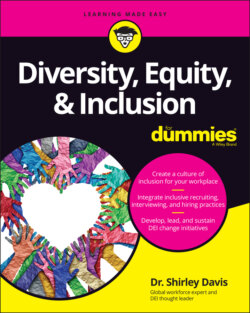Читать книгу Diversity, Equity & Inclusion For Dummies - Dr. Shirley Davis - Страница 21
Ability and disabilities
ОглавлениеEqual and fair opportunities should be made to all employees regardless of ability. However, disability diversity isn’t often widely discussed within the DEI conversation. Employers have indicated the anticipated (not actual) costs of adapting the workplace for a differently abled individual as the main barrier to hiring differently abled (disabled) people. Researchers have found that this assumption is really a result of unconscious bias. I discuss unconscious bias later in the chapter, but first I want to give you a clear understanding of the definition of disability.
The World Health Organization (WHO) defines disability as an umbrella term that covers impairments, limitations, and restrictions on participation. It distinguishes an impairment as “a problem in body function or structure,” a limitation as a “difficulty encountered by an individual in executing a task or action,” and participation restriction as “a problem experienced by an individual in involvement in life situations.” Ability refers to one who has the “skills to complete a task, or activity,” so disability can affect how well a person can do any task related to their job.
So the term disability is more complex than simply physical health. Today, WHO estimates that over 1 billion people (15 percent of the world’s population) lives with a disability, and this number continues to rise. Almost everyone will temporarily or permanently experience disability at some point in their life.
In the United States, the Americans with Disabilities Act (ADA) prevents companies from discriminating against people with disabilities in employment decisions. But hiring is only the first step; businesses also need to create a work environment that makes reasonable accommodations for people with disabilities so they can perform the essential functions of the job.
All countries who are a part of the United Nations have also adopted laws and acts to protect people with disabilities as their contributions toward the achievement of the Sustainable Development Goals (SDGs) and the pledge of the 2030 Agenda for Sustainable Development to “leave no one behind.”
